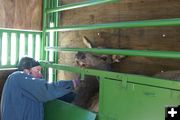

Bleeding elk
A Wyoming Game and Fish
Department employee takes a blood sample from an elk at the Muddy Creek elk feedground to test for brucellosis.
|
|
It's all in the math: WG&F calculates costs
by Cat Urbigkit, Pinedale Online!
June 25, 2007
Although the latest results from the Wyoming Game and Fish Department indicate that the recent test-and-removal program for elk at the Muddy Creek feedground cost some $22,563 per elk removed, the lesson to be learned may be that itís all in the math.
On the expenditure side, WG&F tallied the total cost of the portable elk trap ($153,730), salary and fringe benefits ($89,702), travel expenses ($14,793), lab costs ($16,219), vehicle usage ($16,076) and meat processing ($2,794).
Those line items total $293,314. To come up with how much that cost per elk, WG&F then divided the total cost by 13, the number of brucellosis seropositive animals removed from the feedground.
But is that a fair calculation? Probably not.
First, a lot more than 13 elk were processed through the trap this second year of the program. All the elk processed were sexed, aged, and permanently ear tagged for future identification, so the agency will be able to learn about elk movement, in addition to learning any future change in disease status of these animals. Taking this into consideration, perhaps the total cost should have been divided by the total number of elk bled for brucellosis (79) which would make the cost per elk processed only about $3,712.
But the number should probably be even less.
In coming up with the cost-per-elk removed, WG&F included the cost of the trap again. The agency put that into the tally last year as well. WG&F didnít pay for the $153,730 trap twice, so putting that cost in twice really isnít legitimate. When that cost is removed, the cost is more like $1,766 per female elk processed. Thatís not near as dramatic a number as WG&Fís $22,563. The number would be even less if we included the males tagged and processed in the trap on those days as well.
In a press release this week, WG&F reported, ďEven though the cost per elk increased significantly from $5,911 in 2006, the total cost of the trapping operation remained nearly stable.Ē
Last yearís figures suffer the same flaw. Total expenditures last year were $310,856. If the number of elk processed and tested were used (171) instead of the number of elk removed (58) the results are much smaller Ė about a third, at $1,817.
While WG&Fís numbers may not be a comprehensive reflection of the costs associated with the test-and-removal program, there are some valuable numbers.
Ten percent of the cow elk recaptured in 2007 (also captured/tested in 2006) seroconverted, indicating an exposure event likely occurred during winter/spring of 2006. Three of the four elk that seroconverted were culture positive, potentially indicating recent exposure.
"We won't know how effective we have been at reducing overall brucellosis prevalence in the herd until the 5-year project is completed and we've analyzed the results," said Scott Talbott, WG&F Assistant Wildlife Division Chief. "The project will be limited to the Pinedale elk herd until a detailed assessment has been made after the conclusion of the project in 2010."
|